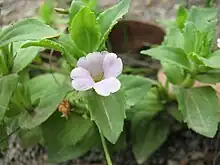| Gratiola peruviana | |
|---|---|
 | |
| Gratiola peruviana in Kinglake National Park, Australia | |
| Scientific classification | |
| Kingdom: | Plantae |
| Clade: | Tracheophytes |
| Clade: | Angiosperms |
| Clade: | Eudicots |
| Clade: | Asterids |
| Order: | Lamiales |
| Family: | Plantaginaceae |
| Genus: | Gratiola |
| Species: | G. peruviana |
| Binomial name | |
| Gratiola peruviana L.[1] | |
| Synonyms | |
|
Gratiola latifolia R.Br. | |
Gratiola peruviana, commonly known as austral brooklime, is a small perennial herb in the family Plantaginaceae.[1] The species is native to South America and Australasia. It grows to between 10 and 30 centimetres high and has pink or white tubular flowers with red-purple stripes inside.[2] These are followed by ovoid capsules that are up to 7mm long. The stem-clasping ovate leaves are arranged in opposite pairs and have shallowly toothed edges.[3]
It occurs in the vicinity of waterbodies in shallow water, mud or dried areas.[3] In South America, the species is native to Peru, Brazil, Chile and Argentina.[4] In Australasia, it occurs in New Zealand and the Australian states of South Australia, Tasmania, Victoria, New South Wales and Queensland.[1][5] The name has been misapplied to Gratiola pubescens in Western Australia.[6]
References
- 1 2 3 "Gratiola peruviana". Australian Plant Name Index (APNI), IBIS database. Centre for Plant Biodiversity Research, Australian Government, Canberra. Retrieved 13 February 2011.
- ↑ Wild Plants of Victoria (database). Viridans Biological Databases & Department of Sustainability and Environment. 2009.
- 1 2 "Gratiola peruviana". PlantNET - New South Wales Flora Online. Royal Botanic Gardens & Domain Trust, Sydney Australia. Retrieved 13 February 2011.
- ↑ "Gratiola L". Flora of Chile. eFloras.org. Retrieved 15 February 2012.
- ↑ "Gratiola peruviana". New Zealand Plants. Landcare Research. Retrieved 15 February 2012.
- ↑ "Gratiola pubescens". FloraBase. Department of Environment and Conservation, Government of Western Australia. Archived from the original on November 30, 2012. Retrieved 15 February 2012.